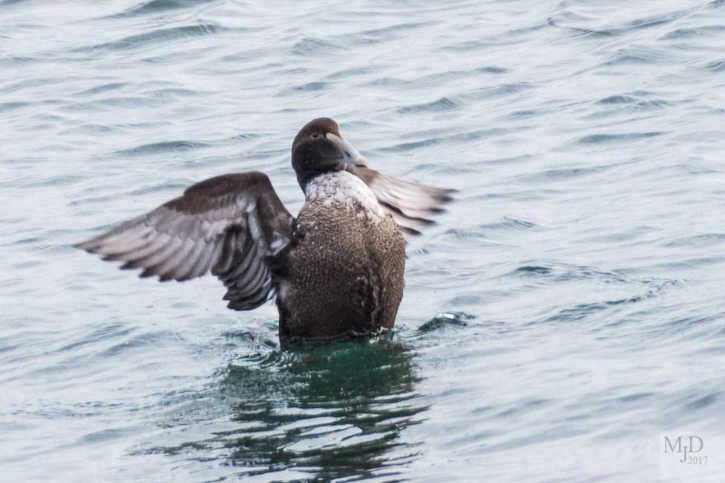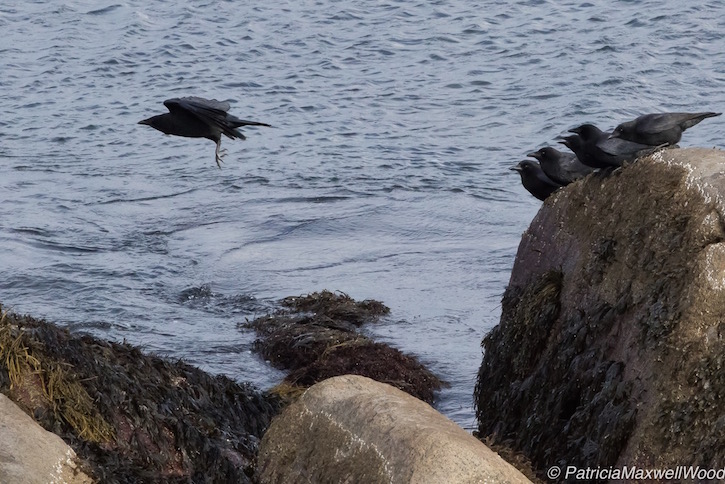The word for this week’s excursion was “lee,” as in the lee of the shore. A smaller than usual group joined Dave Weaver and me in Gloucester, with strong, steady wind and gusts beyond 30 mph in the forecast. Fortunately for us, the wind came from the west, and most of the sites we were headed for faced east. We found birds huddling in the lee of a building starting in Gloucester Harbor, where the crowd of gulls normally spread across the grassy-green roof of the warehouse in town was instead crammed along the wharf beside the east wall of the structure. The biggest raft of Common Eiders that we found was not out near the wharf next to the Coast Guard station, but in the channel formed by the fish pier, right up against the eastward-facing bulkhead. Scoters, it seems, are a bit tougher, as both White-winged and a lot of Black Scoters ranged across the harbor in various configurations. One young Long-tailed Duck later proved to be our only sighting of that species for the morning.

Common Eider upright – Mike Densmore
The next stop was at the still unfrozen Niles Pond. It was dominated by Mallards, many of which are also showing up unusually on Joppa Flats. Perhaps it’s because they are finally being driven south by the approach of truly cold weather and the closing of open water in the north. At Niles Pond, there were also plenty of Ring-necked Ducks. The main flock of many cooperatively feeding Red-breasted Mergansers still contained a female Common Merganser. A tight group of Hooded Mergansers dashed across the pond at our arrival. A loose raft of Lesser Scaup seemed to welcome a lone hen Ruddy Duck. A young Double-crested Cormorant sat looking dejected on a stone, while a similarly still Great Blue Heron prepared to lurk along the shore on the far side. When we go to Cape Ann, the passerine listings usually happen at Eastern Point or Niles Pond, and the enormous shrub hedges by the pond made good cover for a few this week.

Buffleheads on Niles Pond – Patti Wood
The first thing we hope for at this time of year as we head to Atlantic Road is to find Great Cormorants on “Cormorant Rock.” There were nine there this week! The sea we observed for the rest of the day varied from smooth surface by the shore to a violent tumult far out, where ten Canada Geese, the only observed that morning, flew south. Given the conditions, surprisingly few seabirds ranged along Atlantic Road near the rocks. The usual crowd of Buffleheads bobbed in the cove near Bass Rocks, and we did find scoters and the odd loon, but it seemed odd that that shore was so barren. Perhaps it was because we were there for a particularly low tide, and there may well be places they go to forage at low-lows that we didn’t visit, or they were hanging out at better-protected spots. Now and then we saw American Crows picking around in the kelp.

Great Cormorants on Cormorant Rock – David Moon
This week we made it onto Good Harbor Beach, where we scanned up and down for the wintering King Eider, then quickly beat a retreat given the threat of hypothermia. We just fit our group into the overlook on Bass Rocks Road. Paul Sullivan met the owner of one big house there, who said he sees the King Eider “all the time.” He did not know what it was until Paul showed him some photos from iBird Pro and brought him up to speed. Joppa birders lead the way! If you go up there, please be very respectful of private property, so that birders can continue to search for this treat without conflict with residents.

American Crows foraging in the intertidal – Patti Wood
We didn’t have the luck to see the King Eider on Wednesday, but we did get great looks at sheltering scoters and Common Eiders. I shared my argument regarding the metaphysical reality of birding: disappointment after long searching, especially if conditions are uncomfortable, is required for the eventual easy discovery of a coveted sighting. The best part of this theory is that there is no clear relationship between how much suffering is required and how great the reward. Hence, those trying times are welcome as they simply put more in the bank towards eventual joy. Such musings were met with anticipated jeers and sarcasm, no matter how true this magical reality may be.

Harlequin Ducks – Patti Wood
After a pit stop at the public loos in Rockport Harbor, we moved on to Granite Pier. The view of the sea there is magnificent, and we enjoyed scattered seabirds and the awesomely frightening appearance of the far-offshore stretches of ocean. The pier was absent of Harlequin Ducks, and we guessed we probably wouldn’t be seeing them at Cathedral Ledge either. A big group of scoters off of Phillips Avenue looked promising, though, and when we did see them better from the ledge, we enjoyed beautiful drake Surf and White-winged Scoters. Happily, the big rafts of Harlequin Ducks we expect at Cathedral Ledge were indeed there, staying even closer in the sheltered cove to the north than they usually do.

Northern Gannet – Mike Densmore
At Andrews Point, the pain of exposure to the punishing gale became real for us. All morning we had certainly lingered outside only briefly, but on the point it was a struggle to remain upright! Northern Gannets flew close in as they often do there, though, and we saw more Harlequin Ducks and beautiful drake Black Scoters; most of the scoters we had seen thus far were hens and young drakes. But it didn’t take long to cry “Uncle,” and we scurried for shelter, satisfied that we had done our part to ensure a future bountiful morning of sightings for a larger crowd, hopefully during some midwinter thaw. You’re welcome, fair-weather birders!

WMB’rs can take it – David Moon
Our list:
Canada Goose (10) – well out to sea off Atlantic Road.
Mute Swan (2) – juvenile, Niles Pond; ad, Rockport Harbor (not looking in
very good shape).
American Black Duck (5) – Good Harbor Beach marsh.
Mallard (~ 35) – Niles Pond.
Ring-necked Duck (~ 11) – Niles Pond.
Lesser Scaup (15) – Niles Pond.
Common Eider – common.
Harlequin Duck (~ 42) – ~35, Cathedral Ledge; 7, Andrews Point.
Surf Scoter (~ 8) – Cathedral Ledge.
White-winged Scoter – common.
Black Scoter – common.
Long-tailed Duck (1) – Jodrey Fish Pier.
Bufflehead – common.
Common Goldeneye (3) – 1 hen, E. Point Blvd; pr, Niles Pond.
Hooded Merganser (7) – Niles Pond.
Common Merganser (1) – hen, Niles Pond.
Red-breasted Merganser – common.
Ruddy Duck (1) – hen, Niles Pond.
Red-throated Loon (2) – Cathedral Ledge.
Common Loon (5) – various.
Northern Gannet (5) – Cathedral Ledge & Andrews Point.
Double-crested Cormorant (1) – juvenile, Niles Pond.
Great Cormorant (10) – 9, “Cormorant Rock,” Atlantic Rd; 1, Granite Pier.
Great Blue Heron (1) – Niles Pond.
Herring Gull – common.
Great Black-backed Gull – common.
Rock Pigeon
American Crow (~ 7) – various.
Black-capped Chickadee (2) – Niles Pond.
Tufted Titmouse (2) – Niles Pond.
American Robin (1)
European Starling
Northern Cardinal (3) – Niles Pond.
House Sparrow – many, Niles Pond.


